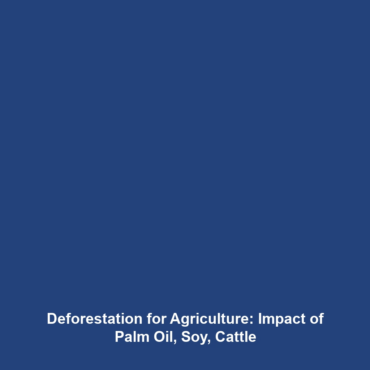Deforestation for Commercial Agriculture: A Catalyst for Biodiversity Loss
Introduction
Deforestation for commercial agriculture, particularly in the production of palm oil, soy, and cattle ranching, has become a critical environmental issue. This practice not only accelerates the loss of forested areas but also has profound implications for biodiversity loss globally. As forests are cleared to meet increasing demands for agricultural products, countless species face extinction, and ecosystems are irreversibly altered. Understanding the multifaceted relationship between deforestation and biodiversity is essential for creating sustainable agricultural practices that protect our planet.
Key Concepts
Understanding Deforestation for Commercial Agriculture
Deforestation refers to the large-scale removal of trees from forested areas, often to make way for agricultural activities. Key concepts include:
- Palm Oil: This highly profitable crop requires vast areas of tropical rainforest to cultivate, leading to significant habitat loss and disruption.
- Soy Production: Primarily linked to animal feed and biofuel, deforestation for soy planting contributes significantly to habitat degradation, particularly in South America.
- Cattle Ranching: As one of the leading causes of deforestation, cattle ranching transforms expansive areas of forest into grazing land, leading to severe biodiversity loss.
Applications and Real-World Uses
Deforestation for commercial agriculture is intertwined with various applications in economic development and consumer markets:
- How Palm Oil is Used: Used in a multitude of products, including food, cosmetics, and biofuels, the demand for palm oil drives extensive land clearing in tropical regions.
- Applications of Soy: Soy is a crucial ingredient in livestock feed and biofuels, affecting land use patterns and contributing to the decline of native species.
- Cattle Ranching Practices: Beef production relies heavily on deforested land, often displacing wildlife habitats and leading to soil degradation.
Current Challenges
Studying the impacts of deforestation for commercial agriculture presents several challenges:
- Data Collection: There is often a lack of comprehensive data regarding land-use changes and their ecological consequences.
- Policy Implementation: Inconsistent enforcement of environmental regulations hinders efforts to mitigate deforestation impacts.
- Consumer Awareness: Many consumers are unaware of the ecological effects of agricultural products, resulting in continued high demand.
Future Research and Innovations
The future of research in this field involves innovative approaches to reduce deforestation while meeting agricultural demands:
- Sustainable Practices: Research into agroforestry and regenerative agriculture may provide solutions that balance productivity with environmental conservation.
- Alternative Crops: Developing economically viable alternatives to palm oil and soy can decrease reliance on deforested land.
- Technological Innovations: Drones and satellite technology are being employed to monitor deforestation in real-time, aiding in conservation efforts.
Conclusion
Deforestation for commercial agriculture, particularly concerning palm oil, soy, and cattle ranching, poses a significant threat to global biodiversity. It is imperative to address these issues through sustainable agricultural practices and consumer awareness initiatives. To further educate yourself on the implications of deforestation and ways to combat biodiversity loss, please explore our resources on sustainable agriculture and biodiversity conservation.
